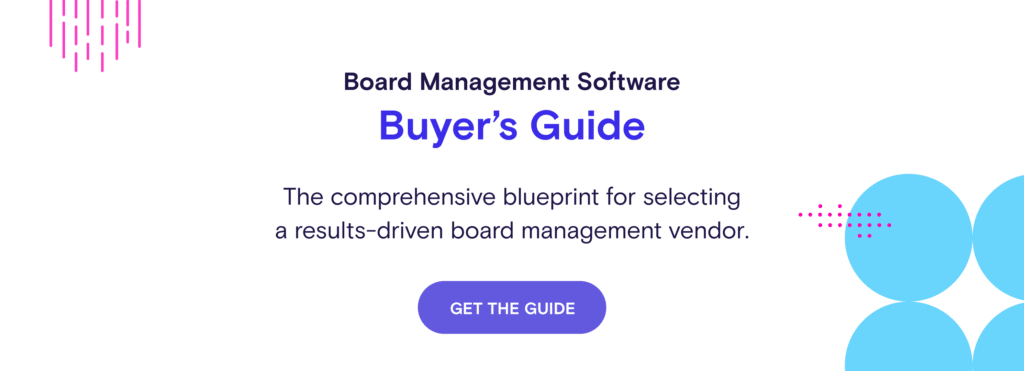
Board meetings can easily veer off-track. But veteran board member Michael Girdley has built a proven method to hold foolproof board meetings.
If you’ve served as a board member, you know the potential pitfalls and headaches that await board meetings with great intentions but poor follow-through.
They range from going off-topic to an imbalance in who holds the floor to running out of time to cover high-priority agenda items.
Michael Girdley knows a thing or two about the problems boards face—both in and out of meetings—and the practices that get them back on track. Michael is an entrepreneur and investor who co-founded the early-stage venture capital firm Geekdom Fund, and he currently runs a holding company that does $100M a year in revenue (his latest project is launching a course to teach everything he’s learned about running a holdco.)
He has served on 18 boards and currently sits on the boards of companies including Codeup, Grok Interactive, Prospectify, RealCo, and Alamo Fireworks.
As a veteran board member, he says the best boards bring a high level of investment.
“It’s great if everybody has some level of personal commitment—the most effective boards I’m on are that way,” Michael says.
When members are invested in the success of the business—and, by extension, the board—that commitment leads to better meetings and a healthier board.
We sat down with Michael to dive deeper into his foolproof board of directors meeting format, including key elements and how they foster good board health.
Before the meeting…
Prepare and send the agenda 72 hours ahead of time
The first element of a foolproof board meeting occurs about a week before the meeting begins. The CEO or chair should prepare the agenda and then distribute the agenda and slide deck at least 72 hours before the board meeting.
Board members are responsible for reviewing materials, coming prepared, and arriving on time. In fact, this is exactly what Michael seeks as an investor when determining if the boards are high-performing or not.
“If you see people running with really good tactics, that’s a good thing,” he says. “Materials are sent out ahead of time, they come out and they’re complete, [members] are on time.”
Learn how OnBoard’s Agenda Builder makes meeting scheduling and sending materials to your board members simpler than ever.
Tips for creating a foolproof agenda:
- The CEO and board chair should meet ahead of time to establish the key objectives of the meeting, before the meeting starts.
- Work backward from there to determine what else can be included in the agenda.
- Use time blocking to make sure you’ll be able to keep the meeting on track.
Why board meeting preparedness matters to investors
When asked if lack of board meeting preparedness has ever led Michael to not invest in a company, he answers without hesitation: “Yes.”
The punctuality and preparedness of your board reflects members’ commitment level and speaks volumes about the board’s health—which can, in turn, guide a potential board member’s decision to invest in the company or not.
When asked to join a board, Michael looks for red flags on the tactical side by asking to review recent board decks. He also listens to how the CEO talks about the board and its role. He asks questions about what is and isn’t working well, problems faced over the past year, and how the board addressed those problems.
Those answers give Michael insight into any structural issues the board may have.
“You listen for [little] hints, and you start to see pretty quickly whether it’s high-performing or not,” he says.
Michael knows his role is to be a disruptor who guides strategic changes on the board. If he senses the board won’t be receptive to change or if he notices red flags like poorly run meetings and unprepared members, he doesn’t pursue those investments.
As the meeting begins…
Take a moment to set the tone.
There are 3 key components to kicking off a board meeting, according to Michael:
- Review the agenda. First things first, as the meeting starts, the CEO or chair facilitates a review of the agenda to establish the flow of the meeting.
- Housekeeping: A time-blocked segment for housekeeping opens the floor to members who can suggest topics that aren’t listed on the agenda. These can be added for discussion later in the meeting.
- Culture Review: After reviewing the agenda for the meeting, Michael suggests taking two to three minutes to conduct a brief culture review. He recommends picking one value or expectation to review at the beginning of each board meeting and rotating over time.
The practical power of a culture review
Why a culture review? It’s about setting the tone, and inviting the board members to step up to their role at the table. These three minutes remind the group about who your company is, what you’re building, and why they’re here, Micheal says.
“When you put that type of stuff up front every single time, it basically is an invitation to the chair and to everybody else to hold each other accountable to those things,” he says.
A culture review helps to remind board members that they’re part of the board not because they have to be but because they want to be there. It’s important to create board meetings that are focused and enjoyable, so members can look forward to coming to meetings.
“It should be fun,” Michael says.
On a tactical level, a culture review also segues the meeting from housekeeping and the cursory “How was your weekend?” chats into a more serious tone, preparing the room to dive into the key objectives on the agenda.
“We can use that as the context to dig into the meat of the meeting,” Michael says.
Make culture review a part of every meeting’s minutes with the OnBoard Minutes Builder—that way, board members can effortlessly export for future reference.
During the meeting…
Find the core issue to foster better discussions
When the board meeting reaches the issues session of the agenda, the chair needs to oversee and facilitate the conversation to ensure it remains fruitful.
Michael stands by the Entrepreneurial Operating System (EOS) methodology for solving issues.
“You identify the problem, make sure everybody’s talking about the same issue and narrowly scoped on that. … You discuss it, and only then, once you get all the data out on the table, do you try to solve the issue,” he explains.
This approach gets everyone involved by ensuring everyone agrees on the core issue. At times, this involves “double-clicking” by asking, “Why is that happening?” or “What’s the problem behind that?”
In the case of complex problems, the chair might need to ask those questions multiple times to reach the root cause.
Then, after identifying the core issue, the board must agree on a solution or agree that one person will make the decision.
Managing the flow of conversation
“One of the chair’s jobs is to think about, ‘OK, how do I make the meeting productive?’” Michael says. “You have to be aware at a meta level what the flow is and what people are doing.”
In addition to managing the agenda and keeping the schedule on track, this involves observing and understanding board members.
Throughout the meeting, the chair should watch for signals that a board member is out of sorts but holding back their comments.
Does someone display negative or closed-off body language? If so, how can you draw them out?
Michael offers this example of how to engage a silent board member: “I noticed you were grimacing but haven’t gotten a chance to weigh in yet. If you have any insights to share, I’d love to hear your thoughts.”
At the other end of the spectrum, if a board member is dominating or holding the floor too long, the chair should manage the conversation to engage others. Look out for those who are intently listening but aren’t talking and draw them into the discussion.
A skilled chair masters interpersonal dynamics and has the emotional intelligence to keep board members working together productively.
Tip to keeping the conversation on track: Use the ‘parking lot’
Throughout the meeting, the chair or CEO may need to reroute the discussion to stay focused on key objectives. To keep those side tangents—which may be valuable—from getting completely forgotten, Michael recommends using the idea of a “parking lot.”
These items are put on hold for the issues section later in the meeting, when the board reviews all remaining topics, prioritizes, and reviews them in order.
The chair or CEO might say, “We definitely need to talk about this. Let’s put it in the parking lot and revisit it later.” In Michael’s experience, people are typically receptive.
When the conversation arrives at the parking lot, board members often find other items are much more pressing than their original topic.
“Eventually, members of the board themselves will start to self-police,” Michael explains. “[They’ll] say, ‘This is probably a tangent we shouldn’t go off on now, but let’s put it in that in the parking lot, and we’ll revisit it later on as time permits.’”
Ending the meeting…
Strive for continuous improvement
Another of Michael’s favorite EOS practices is rating the board meeting at its conclusion. No, not after the meeting is over—in real time, while everyone’s still at the table.
Michael recommends everyone share their opinion of the effectiveness of the discussion on a scale from one to 10 and how they think the meeting could be better next time.
The chair or CEO records the rating on the meeting slides to keep track of the performance and improvement of the meetings over time.
The value of a meeting rating
Rating the board meeting has two layers of value:
First, it provides a clear layer of value by bringing forward how meetings could improve. This makes the rating actionable and gives the board members something to work on.
On a meta level, encouraging everyone to speak openly about the positives and negatives of the meeting translates into an understanding of board culture.
“If the board is treating themselves as a continual improvement thing, that promulgates through everybody’s stuff. … It finishes the meeting on a high note, which is good because you want people to feel addicted and [to] want to come back to the next one,” Michael says.
For boards that are ready to dive deep into their meeting analytics, OnBoard is here to help. With real-time insights like which agenda sections are high priority and where notes are being taken, you can prepare better and shape more effective meetings.
Make music with your board meetings
The board exists to serve the business, and the business exists to do the desires of the shareholders.
Regardless of the rating a given board meeting receives or the issues discussed, the mission of the business always needs to remain front and center. Only then can the meeting and board truly be effective.
“A highly functioning board is a great way to have a high-performing company,” Michael says. “I see it as an extension of the team.”
But remember—neither companies nor boards are one-size-fits-all.
“Business isn’t like Bach,” Michael says. “Business is much more like jazz, where you have to look at your situation, look at your resources at hand, and then figure out what note to play next.”
To keep with Michael’s analogy, think of this meeting guide as the sheet music for your board meetings. Just like a jazz band, every member needs to come with instruments tuned (presentations prepped), music prepared (agenda sent) and a focused goal (key objective)—you get the idea. And of course, you want to have some fun in the process—and can’t be afraid to improvise if needed!
While Michael has since given up on guitar lessons (it’s not for everyone), he has attended and led plenty of board meetings. He’s confident these tips for the boardroom can help your board meetings come together and make some sweet music for your business.
Happy playing! Want to make some music happen with your board meetings? Get started with a free trial of OnBoard.
Want to fuel your startup for success? Get started with a free trial of OnBoard.
About The Author

- Adam Wire
- Adam Wire is a Content Marketing Manager at OnBoard who joined the company in 2021. A Ball State University graduate, Adam worked in various content marketing roles at Angi, USA Football, and Adult & Child Health following a 12-year career in newspapers. His favorite part of the job is problem-solving and helping teammates achieve their goals. He lives in Indianapolis with his wife and two dogs. He’s an avid sports fan and foodie who also enjoys lawn and yard work and running.
Latest entries
 Board Management SoftwareApril 12, 2024Board of Directors Compliance Training: 5 Best Programs
Board Management SoftwareApril 12, 2024Board of Directors Compliance Training: 5 Best Programs Board Management SoftwareApril 10, 20245 Best Compliance Training Programs
Board Management SoftwareApril 10, 20245 Best Compliance Training Programs Board Management SoftwareMarch 28, 20245 Advantages of an Initial Public Offering
Board Management SoftwareMarch 28, 20245 Advantages of an Initial Public Offering Board Management SoftwareMarch 26, 2024Initial Public Offering Examples: 3 Companies That Went Public
Board Management SoftwareMarch 26, 2024Initial Public Offering Examples: 3 Companies That Went Public



